Now, it’s time for me to really explore a single area to understand the plants that inhabit it. I’ve decided to spend my time in the Scioto Audubon Metro Park in Columbus, a lovely park where you can rock climb, have a picnic, and watch birds.
Here’s my exploration, so far:
Scioto Audubon Metro Park
The metro park is 160 acres, bordered by I-70/71 to the north and the Central Ohio Greenway Trail to the west. Aptly named, the metro park follows along the Scioto River, and it is positioned next to downtown Columbus and the Brewery District. The park lies above layers of shale and Columbus limestone.

Topography of the park. Thanks, Google Maps.

Master plan of the park, outlining all parts of the park and surrounding areas
The Scioto River provides an interesting riverine ecosystem lined with forested trails, while the adjacent areas of the park are restored wetlands and prairie areas. The wetlands provide an area for lowland trees, shrubs, vines, and flowers to grow and thrive. The prairie areas are largely grassy with smaller shrubs and flowers, and the forested areas lining the trails provide an area for more upland plants to grow.
However, there are more than just plants living here! The area was restored for birds, so the area is perfect for many types of birds to live. I saw quite a few robins on my first trip, and what looked like a great blue heron flying toward the wetlands! Also, the moist environment and plenty of plants house lots of bugs, big and small, and I saw many mosquitoes flying around. But, back on the topic of plants, let’s investigate what we saw recently!
Plants in the Park!
First, I want to look at two new trees I’ve found on my adventure. The first tree I found was an American sycamore (Platanus occidentalis), although it is quite young. I was not very surprised to find this species here, as it was near the wetland which provides rich, most soil. This tree also prefers alkaline soils, which is provided by the limestone underlaying the area. Although wetland soils are not incredibly well-drained, American sycamore can overcome flooding and tolerate wet areas, so it’s not out of place.
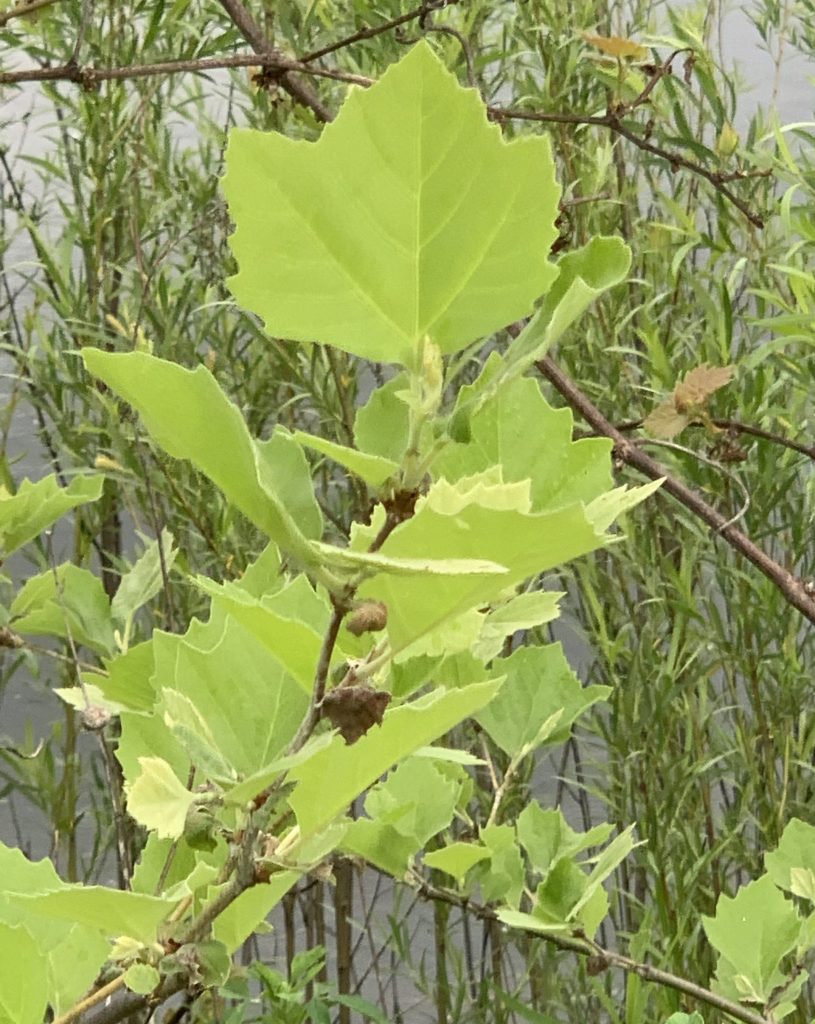
American sycamore, Platanus occidentalis (from quite far away)
The next tree I found was black willow (Salix nigra), once again near the wetland areas. I found quite a few of these trees in a small area, some looking more like shrubs (which they can also be classified as), but many were small or medium-sized trees. This willow prefers moist or wet soil, but one of its notable traits is its ability to tolerate very wet sites. I found out that these trees, along with other willows, are great food for animals to browse. Elk and beaver, in particular, will browse on willow leaves during summer and willow twigs during winter (source: plants.usda.gov).

Black willow tree, Salix nigra, in wetlands
———————————————–
Next, I looked into some shrubs and woody vines that inhabit the area, and found two shrubs on my walk. The first is a northern arrowwood (Viburnum recognitum). I found this near the beginning of the path that leads through the wetland areas, in a dry, flat area. These plants are characterized by their clusters of small, white flowers that surround the shrub. This shrub is similar to its relative, southern arrowwood (Viburnum dentatum), but the northern variety is typically hairless and more common in northern and northeastern areas of the US. Although these shrubs are pretty, their flowers have a scent that can be unpleasant to many people.
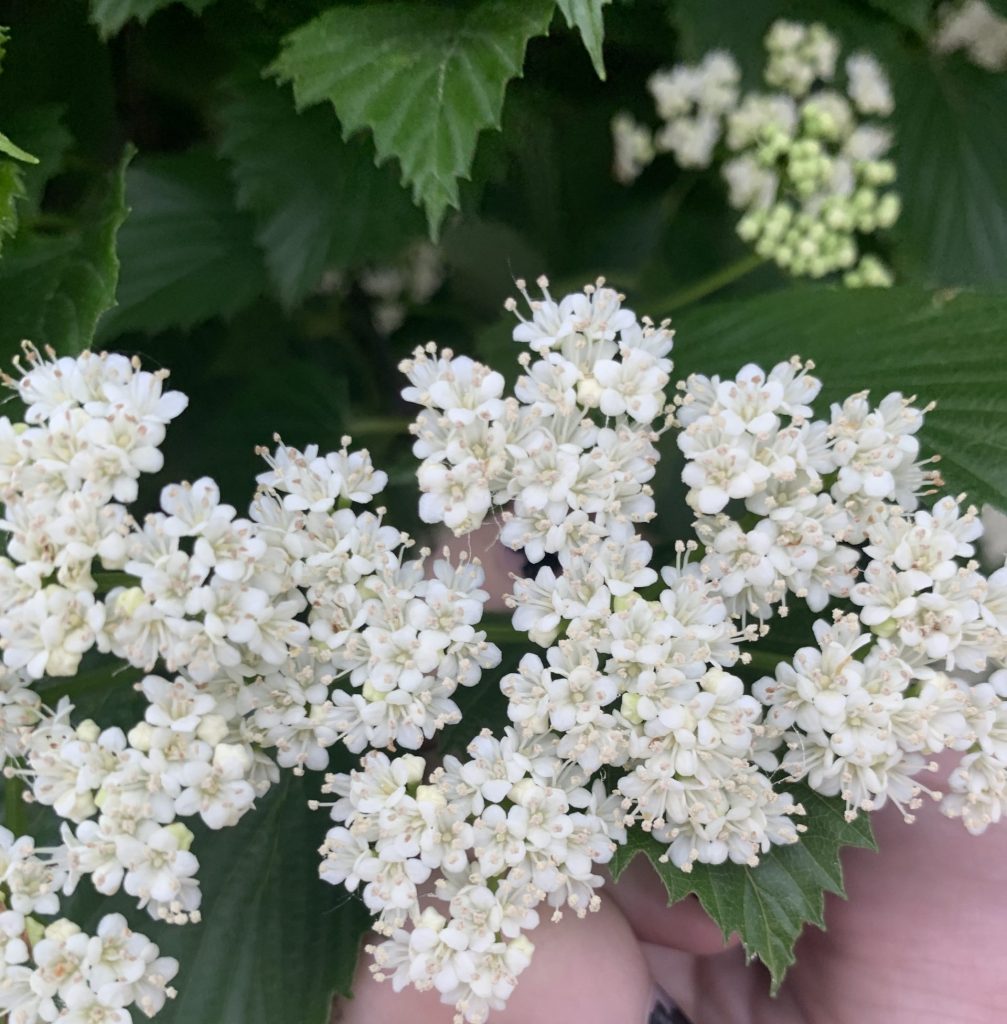
Northern arrowwood, Viburnum recognitum, flowers and some leaves
The second shrub I found was a common elderberry (Sambucus canadensis). Like the last shrub, this plant grows clusters of pretty white flowers, but these flowers don’t bloom until late spring or early summer, so it’s a little too early to see them now. The elderberry plants I found were near a more dry area, a short distance from the wetland areas, near other small trees and shrubs. This shrub is able to survive in both alkaline and acid soils, so the limey Ohio soil is a good habitat for them. Additionally, they also prefer moist, well-drained soil, so their proximity to the wetlands makes sense. Fun fact: although these plants reportedly yield hydrocyanic acid in all parts, their fruits are used in jams and jellies, and eaten by 43 bird species! Perfect for a bird park 🙂
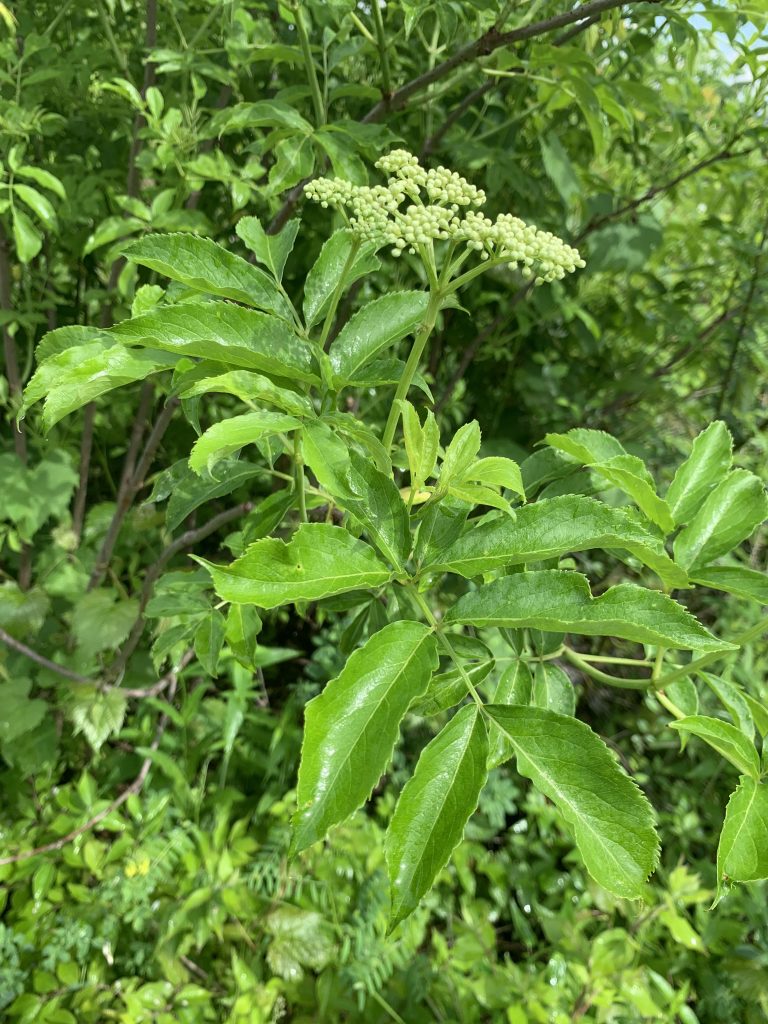
Common elderberry, Sambucus canadensis
———————————————–
Finally, I looked at pretty flowers (again), but not the ones found on our previous shrubs! First, I found two flowers that had bloomed from rough-fruited (or sulphur) cinquefoil (Potentilla recta). These pale yellow flowers caught my eye against the green grasses and largely-leafy plants nearby, near the entrance to the wetland path (although the flowers were not near the wetlands). These beauties are notable for their pale yellow hue and coarsely-toothed leaflets. They’re typically found in dry fields, and are tolerant of alkaline soils, like the limey Ohio soil we know and love. They also produce achenes that are wind-dispersed! Interestingly, this plant is not well-liked in the U.S., partially because cattle and other grazing animals rarely eat it.
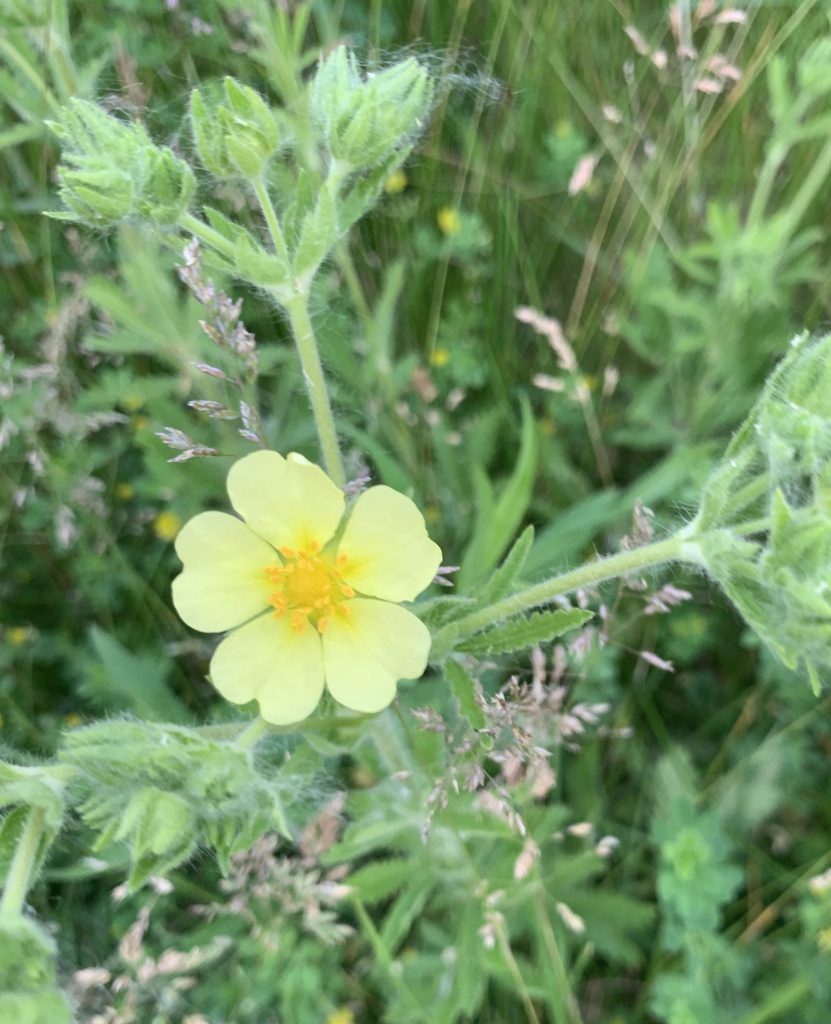
A single rough-fruited cinquefoil flower, Potentilla recta
My second floral find was the multiflora rose (Rosa multiflora), characterized by its white or pinkish 5-petalled flowers and deeply fringed stipules. I found this plant in a wetland thicket, surrounded by young trees and shrubs. This flowering plant is invasive (shocking, I know) and is able to displace nearby vegetation, resisting movement from outside forces. It is able to rapidly and aggressively spread because birds will eat and disperse its many fruits. According to invasive.org, the multiflora rose was originally introduced in the U.S. in 1866 for ornamental purposes.
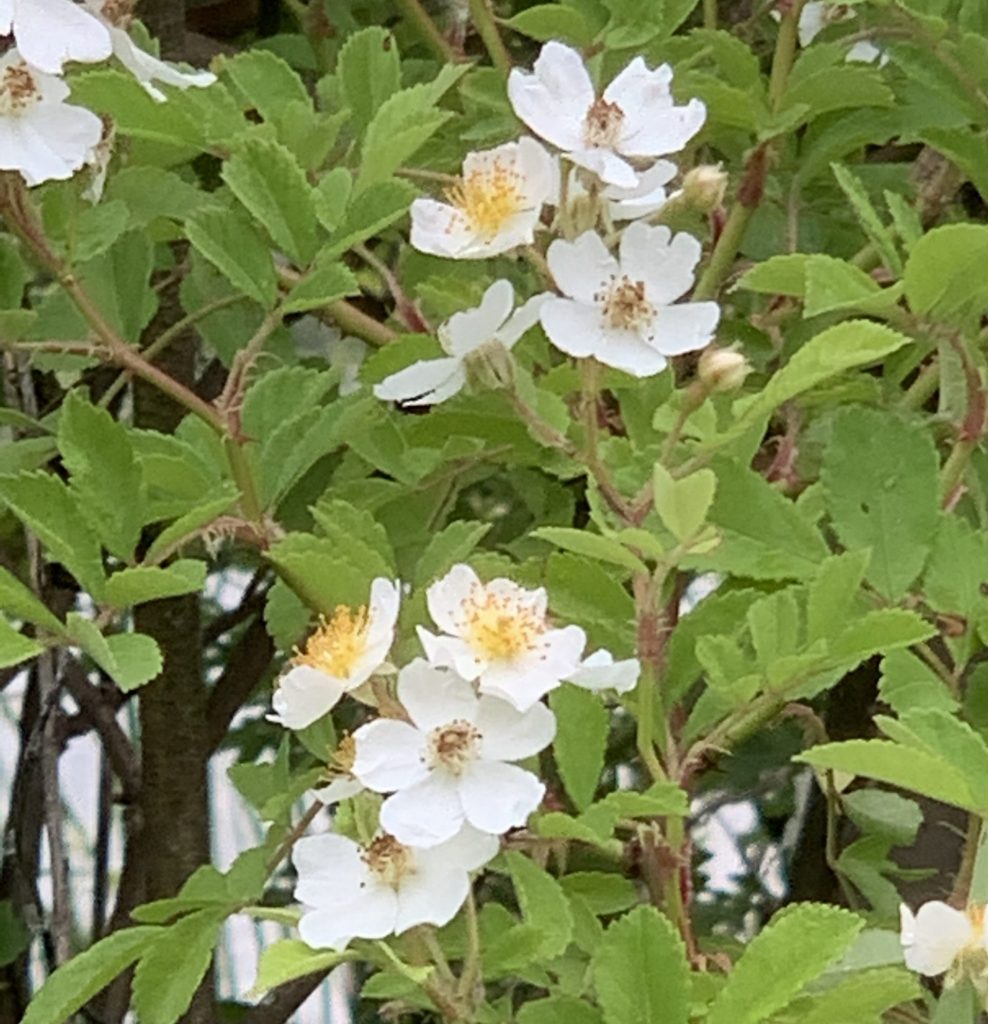
Multiflora rose, Rosa multiflora, from far away because I couldn’t get close
———————————————–
“Leaflets three, leave them be!” Yes, it’s time to talk about *dun dun dun* poison ivy! As many people do, I encountered some poison ivy on my adventure. I was checking out an area on the opposite side of the park’s parking lot, looking at trees, when I noticed a trifoliate plant growing up the trees and through the wire fence. Now, not every trifoliate plant is automatically poison ivy, or even dangerous. Plenty of trifoliate plants are lovely. However, if you see large trifoliate leaves with a long stalk, brown twigs, and its climbing up a tree so you can see short aerial rootlets? Probably best to stay away. And don’t be fooled by thinking, “Well these leaflets don’t look like the other poison ivy leaves I’ve seen,” because poison ivy leaflets can vary in appearance.

AHHH!!!!!!
———————————————–
Coefficients of Conservatism
Today’s journey was for locating plants with varying coefficients of conservatism (or CC). These values are an estimate to tell us how likely a plant is to be a part of a high-quality natural community, or a community similar to unaltered pre-settlement conditions. CC values range from 0 to 10 and were determined and compiled by Andreas et al. (2002). High CC values assigned to plants that are generally indicative of a high-quality, stable environment. These high CC plants typically have more specific habitat needs and are less tolerant of disturbance and change. On the other hand, low CC plants can basically grow anywhere, even in highly disturbed areas, and they indicate a lower-quality site that may have endured much change and disturbance.
The Ohio EPA uses a system known as the Floral Quality Assessment Index (FQAI), where they provide access to CC values for Ohio species. For my adventure, I referenced the FQAI to find different plant species that vary in quality.
———————————————–
High CC Values
The first plant I found at my site today with a “high” CC (I considered 5-10 high values) was a downy juneberry (Amelanchier arborea). This plant is also known as shadbush, downy serviceberry, and common serviceberry. Downy juneberry is a tree or shrub that is taller than many species in its genus, and is characterized by often heart-shaped leaves with long pointed tips and white-hairy undersides, and its reddish purple fruits. It’s CC is 5, so it’s right in the middle of the spectrum. It lives in a variety of habitats and is a late-successional species, so it is late to establish after a disturbance. It is often used for ornamental purposes, but its wood is occasionally used to make tool handles! It’s wood is one of the heaviest in the U.S., but it cannot often be used because the tree itself is not very large.
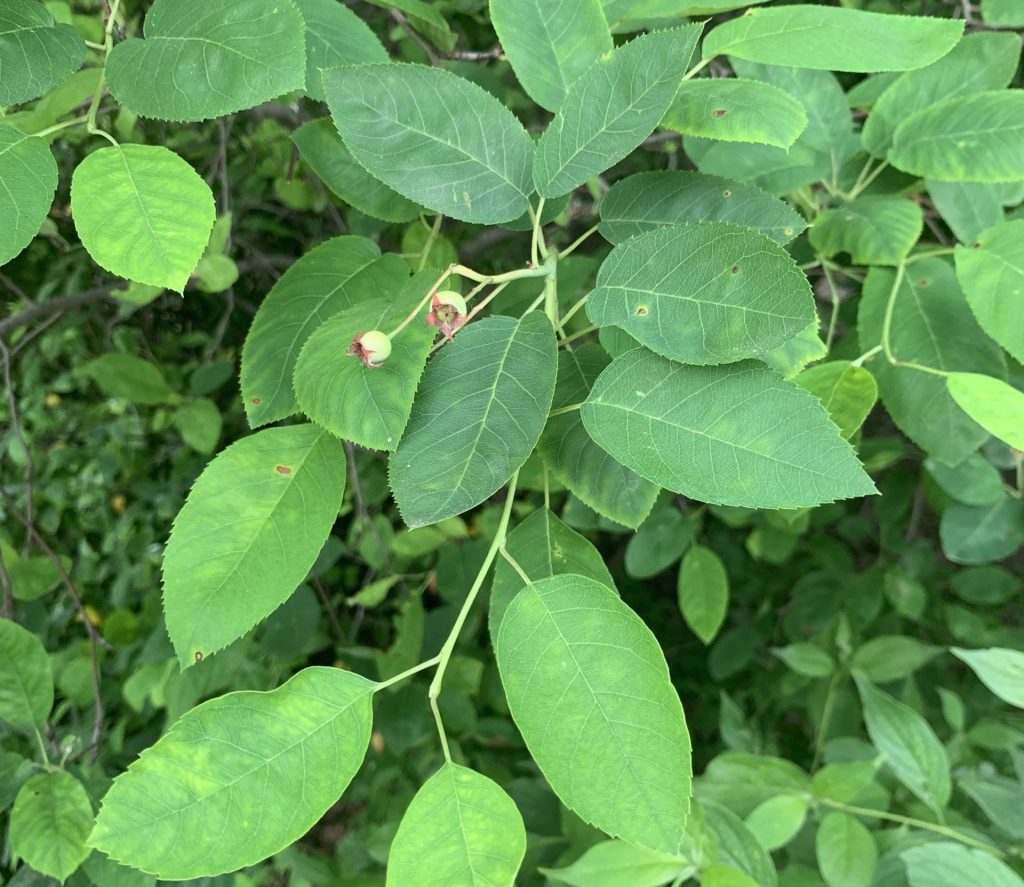
Downy juneberry, Amelanchier arborea
My second plant is a sugar maple (Acer saccharum), with a CC of 5. This large tree is often characterized by its mostly 5-lobed leaves with moderate notches between lobes, as well as a dark brown trunk and reddish-brown twigs. In its natural range, southern Canada and northeastern U.S., it can grow to be 80 feet tall or more. It was named for the sweet sap it produces, used to make maple syrup. Historically, parts of the tree have been used for soap, dye, medicine, and tea!

Sugar maple, Acer saccharum
The third plant in this category is scarlet oak (Quercus coccinea). This species has a CC of 6, and is a medium-sized tree with deeply-lobed leaves, hairless twigs, and dark, finely-grooved bark. It is commonly mistaken for other oak species, typically pin oak, due to similar foliage. Its native range is mostly in the east, extending from southwestern Maine west to Missouri and south to Georgia. It’s generally found in dry, upland sites with well-drained soil. According to the Arbor Day Foundation, the first scientific observations of this tree were made in 1691.

Scarlet oak, Quercus coccinea (on a windy day)
The last high CC plant seen on this walk is trumpetweed, or Hollow-stemmed Joe-Pye Weed (Eupatorium fistulosum). This flowering plant also has a CC of 6, and is characterized by a very tall, hollow stem with 3-7 whorled leaves with a single main vein. The clusters of purple/pink flowers are rounded on top, and the plant grows in moist open areas. This species of Joe-Eye weed has a native range from Quebec to Missouri, south to Florida and Texas. For humans, it has been used to make tea to treat many ailments. For pollinators, the nectar from the flowers is very attractive.
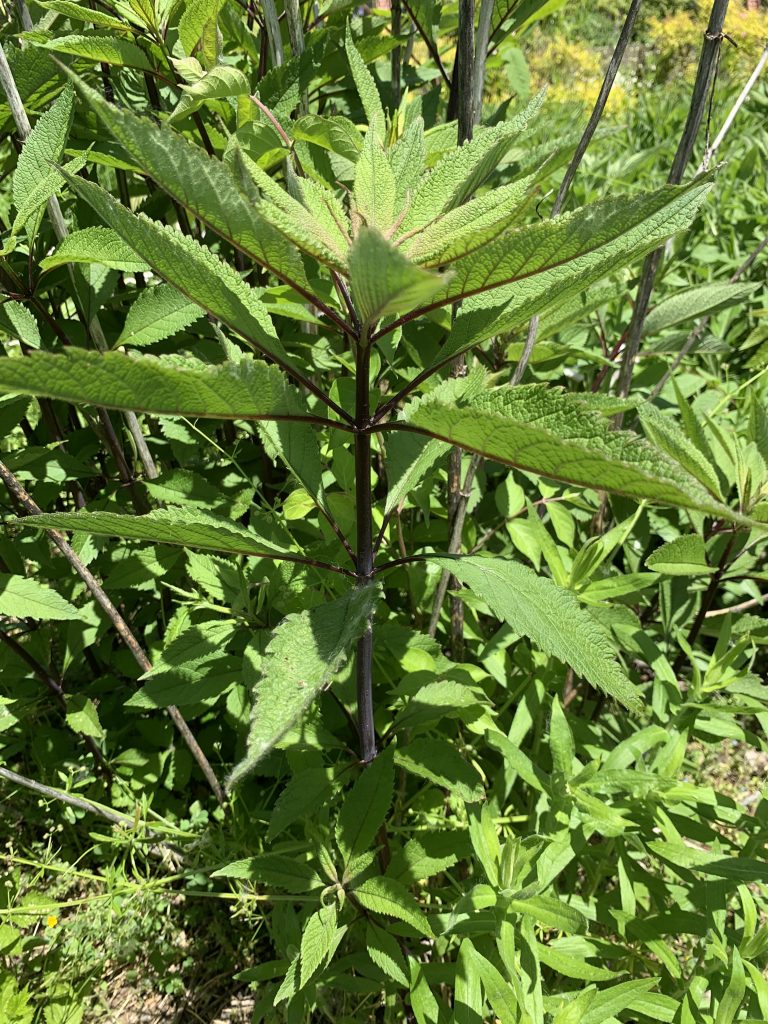
Hollow-stemmed Joe-Pye Weed, Eupatorium fistulosum (without flowers, sadly)
———————————————–
Low CC Values
My first plant with a low CC value was crown vetch (Coronilla varia) and its CC is 0. This score, although seemingly a “horrible” score, only means that the plant has a wide range of tolerances. It is defined by pink and white flowers in an umbel, with 11 to 25 oblong leaflets. It is often planted as ground cover for steep bank areas. It is non-native and has been introduced to most of the U.S. to be used for erosion control. However, it can become weedy and displace other plants if not properly controlled.
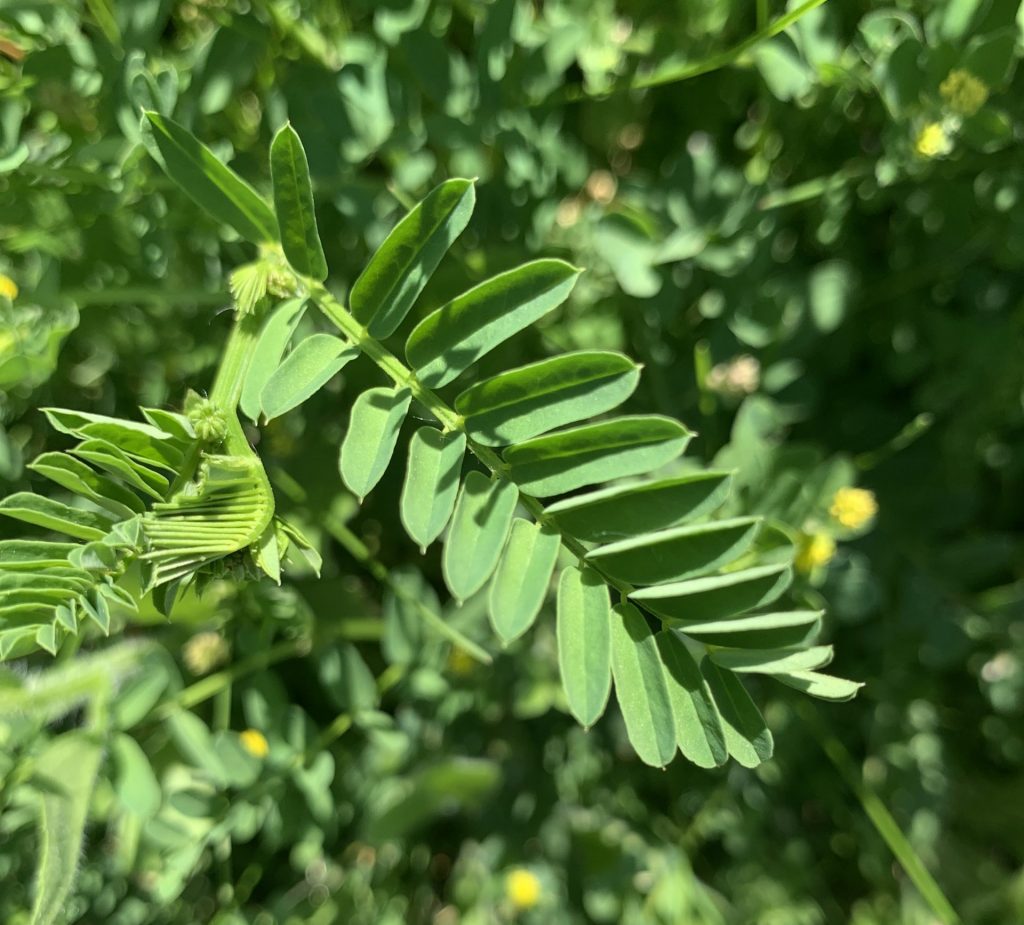
Crown vetch, Coronilla varia (leaflets)
My second plant is common blackberry (Rubus allegheniensis), which has a CC value of 1. This shrub is characterized by white flowers in racemes, prickly stems, and the iconic blackberries (actually an aggregate of drupelets, not a berry). The leaves have 3-7 leaflets, mostly 5, and are palmately compound. It is very common in eastern North America, with many habitats, and its fruits grow best with full sunlight exposure. In its ecosystems, the plant provides both food and cover for many species, like deer, turkeys, and rabbits.
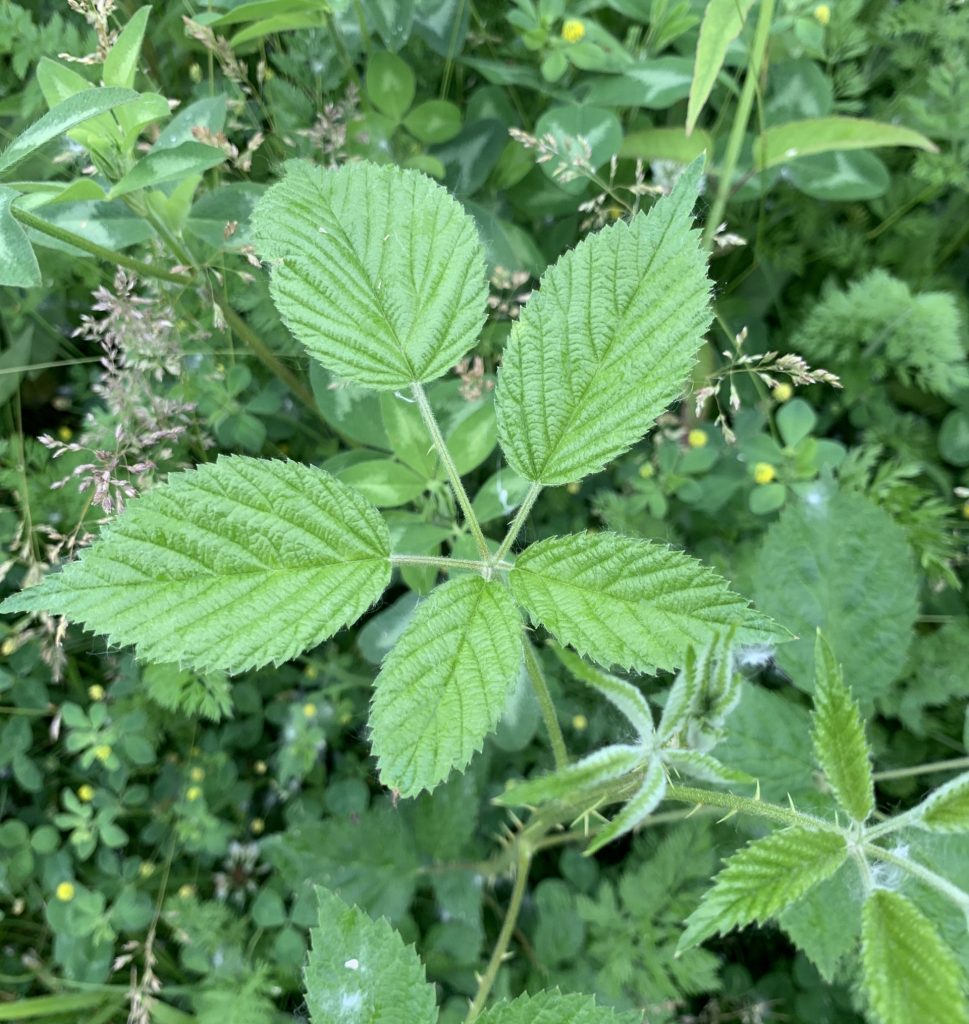
Common blackberry leaflets, Rubus allegheniensis
My third plant is foxglove (or white) beardtongue (Penstemon digitalis), with a CC of 2. This wildflower has white or purple-tinged irregular flowers and smooth stem, with opposite toothed leaves. It’s native range is eastern and southeastern U.S. and it grows in fields and on the borders of woods. It prefers dry to medium moisture and well-drained soils, but can tolerate drought and dry soil. The flowers are attractive to many butterflies, bees, and hummingbirds!
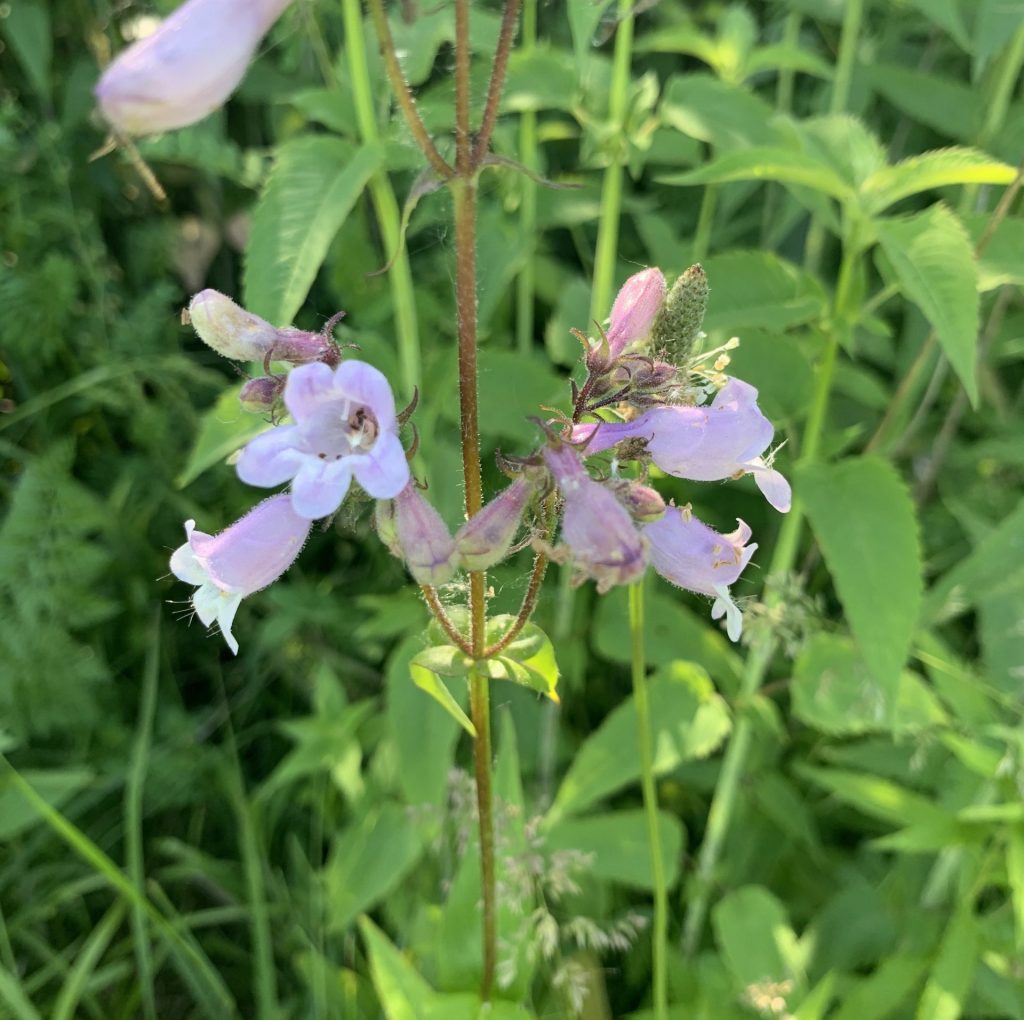
Foxglove or white beardtongue, Penstemon digitalis
For my last plant with a low CC, I came across wild carrot, or Queen Anne’s lace (Daucus carota). It has a CC of 0, as well, and is tolerant of many conditions and habitats. Its umbels are 2-4″ wide with white flowers, and stems are covered in bristly hairs, with alternate divided leaves. It’s very common in dry fields and waste places. It is non-native to North America, and its native range is in certain regions of Europe and southwest Asia. Another name for it, bird’s nest, comes from the concave shape the umbels make when they are maturing.

Wild carrot or Queen Anne’s lace, Daucus carota
———————————————–
Of the plants I found and identified at the site, even those that are not pictured above, I’ve compiled a list of their names and CC values:
(note: non-native plants will be marked with an asterisk)
- American sycamore, Platanus occidentalis – 7
- Black willow tree, Salix nigra – 2
- Northern arrowwood, Viburnum recognitum – 2
- Common elderberry, Sambucus canadensis – 3
- Rough-fruited cinquefoil, Potentilla recta – 0
- Multiflora rose, Rosa multiflora – 0
- Downy juneberry, Amelanchier arborea – 5
- Sugar maple, Acer saccharum – 5
- Scarlet oak, Quercus coccinea – 6
- Hollow-stemmed Joe-Pye Weed, Eupatorium fistulosum – 6
- Crown vetch, Coronilla varia – 0
- Common blackberry, Rubus allegheniensis – 1
- Foxglove beardtongue, Penstemon digitalis – 2
- Wild carrot, Daucus carota – 0
- Sandbar willow, salix interior – 1
- Prickly dewberry, Rubus flagellaris – 0
- Wild bergamot, Monarda fistulosa – 3
- Yellow sweet clover, Melilotus officinalis – 0
- Wingstem, Actinomeris alternifolia – 5
- Fragrant sumac, Rhus aromatica – 3
- Tulip tree, Liriodendron tulipifera – 6
- Poison hemlock, Conium maculatum – 0
- Japanese honeysuckle, Lonicera japonica – 0
- Riverbank grape, Vitis riparia – 3
- Curled dock, Rumex crispus – 0
This formula, I’ = ∑(CCi) / √(Nall species), is used to determine modified FQAI scores for whole sites (from Andreas, 2002). Given the above CC values, the sum of CC values for the site (so far) is 60. Divided by the total number of species, 25, we get a modified FQAI score of 12.
